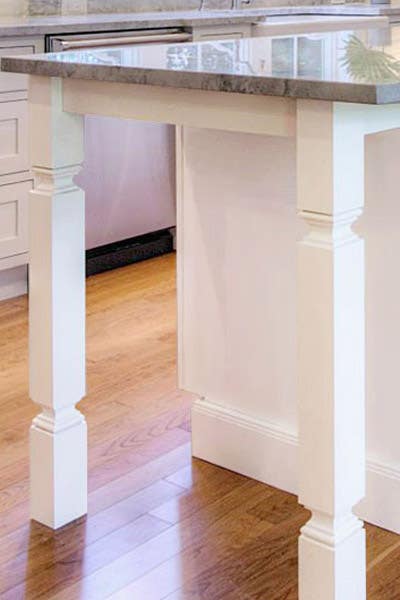Resilient and Fashionable Choices for High-Quality Legs For Kitchen Island
Necessary Variables to Take Into Consideration When Picking Legs For Cooking Area Island
Choosing the suitable legs for a kitchen area island involves a careful evaluation of several factors that can significantly affect both capability and aesthetic appeal. Amongst these, the selection of product plays a crucial function in making sure sturdiness, while the style should complement the existing style. Factors to consider such as height and weight support are vital for stability and convenience. As we explore these components, it ends up being clear that each decision can have far-ranging ramifications for the overall cooking area experience. What nuances should be considered in each of these classifications to achieve the excellent equilibrium?
Material Options
When picking legs for a kitchen island, comprehending the numerous material alternatives is essential for attaining both aesthetic allure and structural stability (Legs For Kitchen Island). The selection of material significantly affects not only the longevity of the island however also its general layout and functionality
Metal legs, commonly made from stainless steel or functioned iron, add a commercial and modern-day feel while making certain durability and stability. These materials are immune to wear and can support significant weight, making them perfect for larger islands.
Another option is crafted products, like MDF or plywood, which can be a lot more economical while still using a series of coatings. However, they may not supply the exact same degree of security as solid timber or steel. Finally, materials such as acrylic or glass can create a modern appearance, though they may require added assistance to make sure stability.
Inevitably, the choice of material for cooking area island legs must align with the wanted capability and the general theme of the kitchen area.
Design And Style

When thinking about style, the shape and surface of the legs are important. Tapered legs can offer a sense of lightness and sophistication, while thicker, a lot more durable legs can communicate stamina and security. Furthermore, the coating-- be it repainted, tarnished, or all-natural-- need to enhance the kitchen cabinetry and kitchen counter products to develop a unified appearance.
Moreover, the design of the legs can also mirror individual preference. Custom-made or ornamental legs, such as those featuring elaborate carvings or distinct geometric shapes, can serve as focal points, including personality and character to the kitchen. Ultimately, the right selection will certainly not just improve performance but additionally boost the aesthetic appeal, making the cooking area island a standout attribute of the home.
Elevation Factors To Consider
Choosing the ideal height for kitchen area island legs is vital, as it directly influences both functionality and convenience. The basic elevation for a kitchen island normally varies from 36 to 42 inches, lining up with common kitchen counter heights.

It is also important to make up individuals' heights and choices. Tailoring the elevation can guarantee a comfy experience for all household members, making the kitchen island a much more practical and enjoyable room.
Weight Support
Ensuring appropriate weight support for cooking area island legs is important for both safety and performance. The kitchen island usually serves numerous functions, consisting of cooking, dining, and added storage, demanding a robust assistance structure. When choosing legs, it is essential to take into consideration the overall weight capability required based on the island's planned use and the products that will certainly be put on it.
The selection of material for the legs plays a considerable duty in their weight-bearing abilities. Strong timber, steel, and durable compounds usually give superior stamina contrasted to lighter products. In addition, the style of the legs-- whether they are straight, tapered, or have a pedestal type-- can affect their great site capacity to distribute weight successfully throughout the structure.
Furthermore, the leg positioning should be tactically prepared to boost security. Legs positioned at the corners or with a broader base can much better sustain heavier loads. Always seek advice from the manufacturer's specifications relating to tons restrictions to make certain that the legs can sustain the intended weight without jeopardizing security. In summary, choosing kitchen area island legs with ample weight assistance is essential for creating a safe and functional culinary space.
Installment and Upkeep
Appropriate installment and maintenance of cooking area island legs are important for guaranteeing long life and stability. This often entails securing the legs to the island base making use of suitable bolts, ensuring that the legs are degree and aligned.
As soon as installed, routine maintenance is needed to preserve the stability and look of the legs - Legs For Kitchen Island. For wooden legs, routine cleansing with a moist towel and application of suitable timber gloss can avoid dampness damage and preserve their coating. Metal legs may call for a mild cleaning option to remove grease and gunk, followed by a dry fabric to avoid rust development
In addition, evaluate the legs frequently for indicators of wear or damages, such as splits or loosened joints. Tightening up screws or bolts as look these up needed can also prolong the life expectancy of the legs. By adhering to these setup and upkeep techniques, home owners can ensure that their kitchen island remains sturdy and visually appealing for years to come.
Conclusion

Aesthetic coherence is vital in picking the design and design of legs for a kitchen island, as these aspects substantially affect the overall ambiance of the area. Tapered legs can provide a sense of lightness and beauty, while thicker, a lot more durable legs can communicate stamina and security.Picking the ideal elevation for cooking area island legs is crucial, as it directly influences both functionality and comfort. In summary, selecting kitchen island legs with adequate weight support is important for creating a risk-free and practical culinary space.
In final thought, picking legs for a cooking area island demands mindful factor to consider of different elements, including material options, design, elevation, weight assistance, and setup.